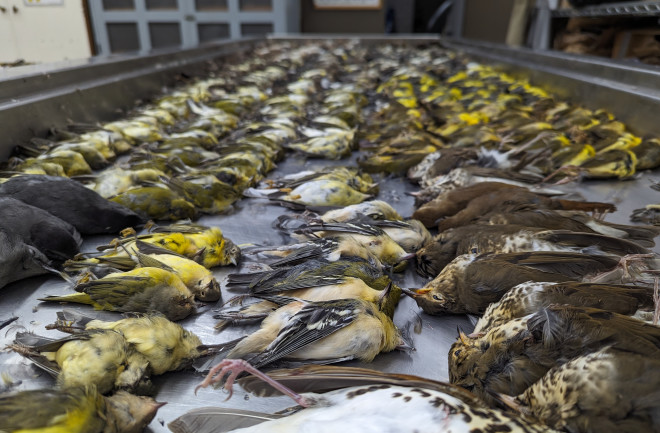Because of adverse weather conditions and city lights, a major migration collision killed 960 birds after they crashed into the McCormick Place convention building in Chicago on Oct. 5, 2023, according to Cornell Lab experts on BirdCast.
“Prior to this, the highest number [of birds] I've ever found at McCormick in one night is 250, which seems massive to start with,” says David Willard, a retired collection manager at Chicago’s Field Museum, who is still involved with the institution.
How Many Birds Die From Windows?
While the numbers are shocking for a single building, 100 million to 1 billion birds die annually in the U.S. from window collisions alone, according to the U.S. Fish and Wildlife Service.
“This one dramatic night shouldn't obscure the fact that there's almost no night during migration [season] when smaller numbers of birds are hitting windows,” Willard says.
Why Did the Chicago Birds Crash?
A heavy rainstorm pushed the birds towards an altitude that made them vulnerable to crashing into buildings, says Willard. That, in combination with the convention centers bright lights, led to the death of almost a thousand birds. As volunteers and monitors counted the window strike casualties, more birds kept smashing into the glass, according to Chicago Tribune's Nara Schoenberg.
It's estimated that 679.4 million birds were traveling nationwide for migration, according to Audubon’s Lauren Leffer. But inclement weather funneled some of the migrating birds into Chicago.
“The number of birds that were ready to take off from central and northern Wisconsin and southern Canada on the night of the fourth was, was gigantic,” says Willard.
Read More: What's Killing the Birds?
Can Birds See Glass?
Although it’s not fully understood, experts say birds that migrate at night are attracted to light that shines through buildings. Birds can't perceive glass as a barrier, so they don't maneuver around to avoid it. The window strikes are most common because when birds fly and see a clear way through a balcony or window, they see it as a shortcut to their destinations and then collide with the glass.
Shiny glass windows also reflect the sky or green spaces and appear as a new environment to explore, according to All About Birds. They may also see green foliage like potted plants from the outside and suspect it's a place to go into to forage, Willard says.
Birds also see differently than humans. While our perception of the world is right in front of us, birds see from the sides of their heads and don't have 3D vision. When they fly, birds are not looking for objects but for movement, and as they fly onward, controlling their speeds is difficult, so the birds may not have enough time to avoid a window.
Why Do Birds Migrate at Night?
When migratory birds fly south, they do so at night to avoid predators. But in heavily light-polluted cities, the building's lights disorientate the feathered travelers. During nocturnal migration, birds, including songbirds, hit windows because they are attached to the light.
About 40,000 dead birds have been recovered since 1978 at McCormick. In a study published in PNAS, researchers who gathered collision data occurring at the McCormick Place in Chicago found that the magnitude of birds migrating at night, wind conditions and how much light is emitted by the urban building predicts the number of bird collisions.
After analyzing two decades of the data, researchers found that bird mortality is reduced at this site by 60 percent if half of the building's lights are turned off during the migration season.
Read More: Birds Stop During Migration to Avoid Disease or Infection
How To Prevent Birds From Hitting Windows
Safeguarding windows against window strikes is one way to prevent birds from hitting windows. Windows can be treated with vertical markings, decals, sticky notes, sun catchers or anything that can deter the bird from hitting the glass. But, placing more than one or two stickers may be required, as most of the window should be covered to prevent birds from colliding with the glass.
Some major U.S. cities, like New York, Houston, Dallas and Chicago, are beginning to implement lights-out plans that help reduce the amount of light pollution and, in turn, save birds from nocturnal window strikes and veering off course. However, some of the programs are only voluntary with no set laws or ordinances. Willard also says that implementing building codes that are bird-friendly may also help.
“One of the biggest frustrations for me in Chicago is seeing new buildings continue to be built that almost look like they were designed to kill birds,” Willard says.
Homeowners and business owners can help by turning off non-essential lights from 11:00 p.m. to 6:00 a.m. every night during migration season. Closing the blinds at night to reduce glare from windows and aiming any lights outside downwards can aid birds in getting to their destinations, according to a post on Birdcast.
Using the Birds for Study
The birds found in this area are photographed as part of a yearly rescue and salvage program in Chicago, where volunteers check around window-strike-prone buildings every morning during spring and fall migration seasons for stunned birds.
Stunned birds may recover and manage to fly away. But they may have internal bleeding and later die. The ones who don't make it are collected and become part of the Field Museum's bird research collection, according to a post from the Field Museum.
Some of these specimen’s that Willard and others collected have shown that migratory birds are getting smaller and may be linked to climate change. “Those specimens have all come back to the Field Museum and they've been involved in studies showing that birds are getting smaller, and data from this has shown kind of unequivocally that light from a building like McCormick, is part of what's causing the causing the problem,” Willard says.
Read More: We Still Don't Know What's Killing the Birds

